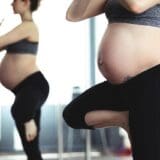During pregnancy, there are countless myths and misconceptions that can cause confusion and anxiety for expectant mothers. Separating fact from fiction is crucial for ensuring a healthy and stress-free pregnancy journey. In this article, we will debunk common pregnancy myths and provide accurate information to help you make informed decisions.
Myth 1: Eating for Two
One of the most common myths surrounding pregnancy is the belief that expectant mothers need to “eat for two.” This popular misconception suggests that pregnant women should consume double the amount of food to ensure a healthy pregnancy. However, this notion is far from the truth.
While it is important for pregnant women to maintain a balanced and nutritious diet, the idea of doubling their food intake is unnecessary and can lead to excessive weight gain. In reality, the caloric needs of a pregnant woman increase only slightly during the different stages of pregnancy.
According to experts, during the first trimester, women do not require any additional calories. In the second trimester, an extra 340-450 calories per day is recommended, and in the third trimester, an additional 450-500 calories per day is sufficient. These additional calories are necessary to support the growth and development of the baby, as well as to provide energy for the mother.
It is important to note that the quality of the food consumed is more important than the quantity. Pregnant women should focus on eating a variety of nutrient-rich foods, including fruits, vegetables, whole grains, lean proteins, and dairy products. These foods provide essential vitamins, minerals, and nutrients that are crucial for the baby’s development.
Additionally, pregnant women should also pay attention to their weight gain during pregnancy. Excessive weight gain can increase the risk of complications such as gestational diabetes, high blood pressure, and difficulties during labor. It is recommended that women consult with their healthcare provider to determine the appropriate weight gain based on their pre-pregnancy weight and overall health.
In conclusion, the myth of “eating for two” is just that, a myth. Pregnant women do not need to consume double the amount of food for a healthy pregnancy. Instead, they should focus on maintaining a balanced and nutritious diet, consuming the recommended additional calories, and monitoring their weight gain to ensure a healthy and safe pregnancy.
Myth 2: Exercise Risks
During pregnancy, there are often misconceptions and concerns surrounding the topic of exercise. Some believe that exercising while pregnant can be risky and harmful to both the mother and the baby. However, it is important to separate fact from fiction and understand the truth about exercise during pregnancy.
Benefits of Exercise:
- Regular exercise during pregnancy can help improve overall health and well-being.
- It can help reduce the risk of gestational diabetes and high blood pressure.
- Exercise can also help manage weight gain and improve mood and sleep quality.
Contrary to popular belief, exercise does not increase the risk of miscarriage or early labor. In fact, staying active can have numerous benefits for both the mother and the baby.
Precautions to Consider:
While exercise is generally safe during pregnancy, it is important to take certain precautions to ensure the well-being of both the mother and the baby. Here are some guidelines to follow:
- Consult with your healthcare provider before starting or continuing an exercise routine.
- Avoid activities that involve a high risk of falling or abdominal trauma, such as contact sports or vigorous, high-impact exercises.
- Listen to your body and modify or stop any exercise that causes discomfort, pain, or shortness of breath.
- Stay hydrated and avoid overheating by exercising in a cool environment and wearing breathable clothing.
- Engage in low-impact exercises such as walking, swimming, prenatal yoga, or stationary cycling.
Remember, every pregnancy is unique, and what works for one woman may not work for another. It is essential to listen to your body and consult with your healthcare provider to determine the most suitable exercise routine for you.
By debunking the myth that exercise is risky during pregnancy, we can empower expectant mothers to make informed decisions about their health and well-being. Regular exercise, when done safely and with proper guidance, can contribute to a healthier and more enjoyable pregnancy experience.
Myth 3: Gender Prediction
Myth 3: Gender Prediction
When it comes to predicting the gender of a baby, there are countless myths and old wives’ tales that have been passed down through generations. From the shape of the belly to the cravings of the expectant mother, these methods claim to have the ability to reveal whether it will be a boy or a girl. But how accurate are these methods, and is there any scientific basis behind them?
Let’s dive into the world of gender prediction and separate fact from fiction. One popular belief is that the position of the baby bump can determine the gender. According to this myth, carrying high means it’s a girl, while carrying low means it’s a boy. However, there is no scientific evidence to support this claim. The position of the baby bump is determined by factors such as the mother’s body shape and muscle tone, not the baby’s gender.
Another common method is based on the mother’s cravings. It is believed that craving sweet foods indicates a girl, while craving salty or savory foods indicates a boy. While it’s true that hormonal changes during pregnancy can lead to changes in taste preferences, there is no scientific basis to link these cravings to the baby’s gender. Cravings are influenced by various factors such as cultural and personal preferences, rather than the sex of the baby.
One method that has gained popularity is the Chinese Gender Chart. This chart claims to predict the baby’s gender based on the mother’s age at conception and the month of conception. However, the accuracy of this chart is questionable as it is based on the lunar calendar and lacks scientific evidence. It’s important to remember that the sex of the baby is determined by the chromosomes contributed by both parents, not by external factors.
So, what methods can provide accurate gender prediction? Ultrasound is the most reliable method for determining the baby’s gender. It uses sound waves to create an image of the baby in the womb and can usually reveal the sex between 18 and 20 weeks of pregnancy. DNA testing, such as non-invasive prenatal testing (NIPT), can also provide accurate results. These methods are based on scientific principles and have high accuracy rates.
In conclusion, while there are numerous myths and old wives’ tales surrounding gender prediction, it’s important to approach them with skepticism. Many of these methods lack scientific evidence and are simply based on superstition or cultural beliefs. When it comes to determining the baby’s gender, relying on ultrasound or DNA testing is the most accurate and reliable approach.
Frequently Asked Questions
- Q: Do pregnant women really need to eat for two?
- Q: Is it safe to exercise during pregnancy?
- Q: Can old wives’ tales accurately predict the gender of a baby?
A: No, the popular belief that pregnant women need to consume double the amount of food is a myth. While it’s true that pregnant women require additional nutrients for the growth and development of their baby, the increase in caloric intake is not as significant as commonly thought. Most experts recommend an additional 300-500 calories per day, depending on individual needs and trimester. Quality and balanced nutrition, rather than quantity, is key during pregnancy.
A: Yes, it is generally safe and beneficial to exercise during pregnancy. However, it is important to consult with your healthcare provider before starting or continuing any exercise routine. Regular physical activity can help improve mood, maintain a healthy weight, and reduce pregnancy discomfort. It is important to choose low-impact exercises that are suitable for pregnancy, such as walking, swimming, and prenatal yoga. Certain precautions, like avoiding high-impact activities and staying hydrated, should be followed to ensure safety.
A: No, old wives’ tales and gender prediction methods are not scientifically accurate. Methods such as the shape of the belly, cravings, and heart rate are simply myths and have no scientific basis. The only reliable way to determine the gender of a baby is through medical methods, such as ultrasound or genetic testing. These methods can provide accurate results, usually around the 20-week mark of pregnancy.











